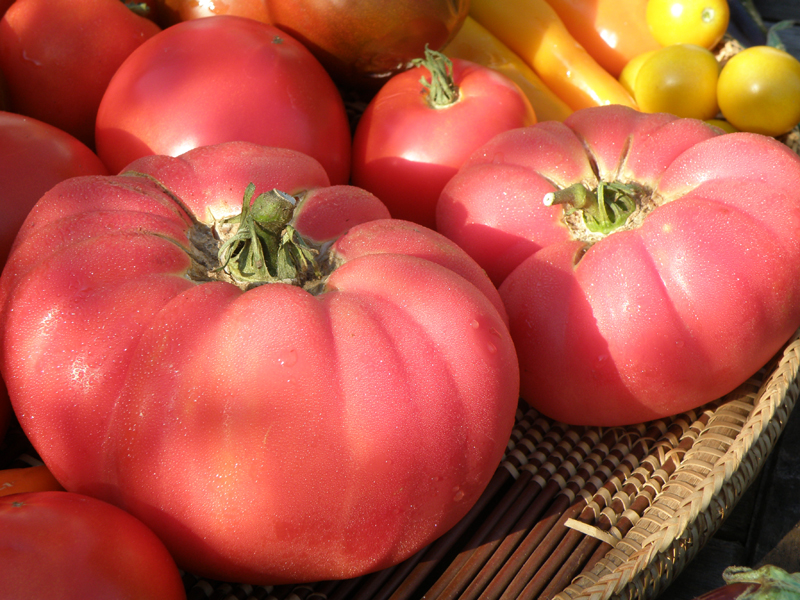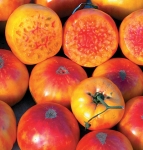TOMATOES - a gardener's notebook
SAVING SEED FROM YOUR HERITAGE TOMATOES
Though tomatoes are a relatively recent addition to our vegetable gardens, there are still a surprising number of 'heritage' varieties around, Most of these were developed in the United States or in the countries of Central Europe (such as Hungary) where tomatoes are extremely popular.
Now, while modern F1 hybrid varieties have to be grown from bought seed each year, heritage varieties have been preserved by gardeners keeping their own seed from the fruit of one year round to save and sow the next year.
You would think that if you grew several different varieties in the same greenhouse, they would all cross-pollinate and the results would be a mongrel mixture. In fact this doesn't seem to happen, and you can grow varieties next to each other, yet save the seed and have them come up the same as the parent fruit the next year. Your website compiler has been growing a variety known informally as 'Roy's Sicilian' because Roy brought back seed from Sicily about 20 years ago, and a group of gardeners has been saving seeds ever since. The plant comes true to type and is very good indeed.
Now, while modern F1 hybrid varieties have to be grown from bought seed each year, heritage varieties have been preserved by gardeners keeping their own seed from the fruit of one year round to save and sow the next year.
You would think that if you grew several different varieties in the same greenhouse, they would all cross-pollinate and the results would be a mongrel mixture. In fact this doesn't seem to happen, and you can grow varieties next to each other, yet save the seed and have them come up the same as the parent fruit the next year. Your website compiler has been growing a variety known informally as 'Roy's Sicilian' because Roy brought back seed from Sicily about 20 years ago, and a group of gardeners has been saving seeds ever since. The plant comes true to type and is very good indeed.
|
Another heritage variety which seems happy to come true, even when grown right next door to 'Gardener's Delight', is the massive and meaty 'Pink Brandywine' from America.
Left: Tomato 'Pink Brandywine'. Click on the pic to go to a fascinating American website on growing tomatoes among other vegetables, 'Bonnie Plants' |
|
To save your own tomato seeds, take them from a ripe, disease-free fruit and spread them out on a piece of kitchen roll with the back of a teaspoon. Leave them to dry and, when all the moisture has gone, cut the kitchen roll up into snippets with one or two seeds on each snippet. When you come to sow, put them in the pot kitchen roll and all.
You'll need to get your heritage varieties to start with of course. The best range we've come across is from SEEDS OF DISTINCTION, who have a huge selection to choose from. They aren't cheap, but then you only have to buy them once . . . |
Tomato 'Hillbilly Potato-leaf - click on the pic to see more
|
Preventing tomato blight - from Gardener's World magazine Jan 2013
How to recognise blight; if you see a rapidly-growing brown spot on a leaf, turn it over first thing in the morning and you may see a halo of white spores. Or take off an affected leaf or two, place in a bowl with a bit of damp kitchen roll. Cover with clingflim and leave overnight. Check it in the morning. If no halo of white spores, probably NOT blight.
List of blight-resistant varieties: Fantasio (Dobies, Suttons), Ferline (Nicky's Nursery, Mr Fothergill, T&M), Fandango (Crocus, Kings), Lizzano (Dobies, Simpsons, Suttons), Red Alert (Crocus, Marshalls, Suttons, T&M), Losetto (Mr Fothergills, Nicky's Nursery, Simpson's Seeds, T&M) Losetto is most blight tolerant.
- Yes it is the same as potato blight
- Worst after a spell of mild damp weather, spores air and rain borne
- If growing in a greenhouse, clean it out well during the winter and change the soil.
- Cover tomatoes to keep rain off; if outside make a tent of polythene
- Leave plenty of space between plants
- Water in the morning, not the evening
- Only water soil and compost, don't splash leaves
- Cover soil with a permeable membrane to keep leaves dry
- Support plants to keep leaves off the soil
- Remove lower leaves and any that are congested to improve air circulation
How to recognise blight; if you see a rapidly-growing brown spot on a leaf, turn it over first thing in the morning and you may see a halo of white spores. Or take off an affected leaf or two, place in a bowl with a bit of damp kitchen roll. Cover with clingflim and leave overnight. Check it in the morning. If no halo of white spores, probably NOT blight.
List of blight-resistant varieties: Fantasio (Dobies, Suttons), Ferline (Nicky's Nursery, Mr Fothergill, T&M), Fandango (Crocus, Kings), Lizzano (Dobies, Simpsons, Suttons), Red Alert (Crocus, Marshalls, Suttons, T&M), Losetto (Mr Fothergills, Nicky's Nursery, Simpson's Seeds, T&M) Losetto is most blight tolerant.



